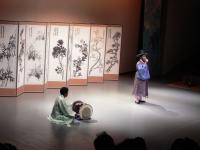Posted on October 13, 2009

South Korea's comprehensive heritage scheme is generally regarded a success by policy-makers, academics and laymen. Most Koreans are indeed aware and proud of their heritage and a significant number of Koreans of all ages are actively involved in the preservation or transmission of cultural properties. Ever since the scheme was set in motion on 10 January 1962 with the promulgation of Law 961, Cultural Properties Protection Law (Munhwajae pohobåp), a large number of tangible, but also all kinds of intangible cultural properties have come under its protection. A committee made up of academics reviewed sites, relics and traditions, and if it considered them sufficiently valuable, it would recommend their listing as a Cultural Property (Munhwajae). Particular emphasis was laid on folk traditions, which distinguished it somewhat from the Japanese 1950 Cultural Properties Protection Law (Bunkazai hogoh'å), on which it was partly based. Since it came to be understood that merely designating intangible cultural properties was insufficient to ensure their transmission and promotion, on 10 August 1970 the Law was revised, and the designation tied not only to the appointment of so-called 'holders' (poyuja) - commonly referred to as human cultural properties (in'gan munhwajae) - but also to their financial support.
As with most heritage protection and promotion schemes, environmental, political and socio-cultural changes have continuously threatened natural and historical treasures. Pollution, erosion and the over-consumption of a specific natural resource are among the obvious examples of factors that provide difficult challenges. In these cases legal measures can lead to positive results. Changes in social norms, on the other hand, may also have long-lasting effects on cultural properties, but because religious convictions are involved, it can be very hard to act against them. For example, whereas in the 1970s and 1980s the military government had controlled public displays of shaman practices which it viewed as superstitious and backward, in the 1990s the growing number of Christians began to also question the need to support cultural traditions belonging to alternative belief systems. Even the Ritual of Paebaengi (Paebaengi kut), a partly sung, partly narrated folk story that ridicules Buddhists, Confucians and shamans, has for this reason been renamed Story of Paebaengi on a few occasions in the recent past.
Arguably less forgiving Christians certainly do not provide the only challenges. Although society is changing, the Confucian ideal of a household where the husband goes out to provide for his family and the wife stays home to care for the children remains strong. Since married women rarely require a full income from their out-of-home activities and chances of a full income from a Korean traditional art slim, the number of women engaging in a tradition has come to exceed that of men. As a result, many women today perform farmers' music and the mask dance even though the traditions used to be predominantly male. The government for long resisted appointing women as 'holders' for such traditions, but it has succumbed where women constituted the only candidates or where they proved to be by far more talented than their male counterparts. In a different case, the Folksongs from KyÅÂnggi Province (KyÅÂnggi minyo), the committee listed the male teachers of the eventual all-female 'holders' as main candidates, but it decided to appoint the men for another style of singing instead, in part, I presume, because of the large number of students involved in either style, and because it would add important diversity to the overall repertoire.
The scheme has thus undergone some adjustments to better suit its purpose. Among those are also the introduction of less traditional music variety shows, such as Pan and Miso, which mix unauthentic elements with segments of traditions to create a diverse and arguably much more visual show. As long as authentic renderings of Korean traditions are guaranteed, I believe the current realm of activities in Korean traditional culture is a very healthy one. Despite the fact that South Korean society today is radically different from what it was in the sixties, its purpose remains largely unchanged. It is still aimed primarily at generating national pride, which a priori should allow a greater degree of authenticity. Following the huge success of Korean popular culture across Asia since the mid nineties, many policymakers have begun to associate Korea's culture with 'soft power'. They make efforts to underpin the dynamic and they attempt to promote Korea's cultural heritage with a view to creating a stronger presence of Korean culture overseas and benefit from the increased appreciation for Korean culture it yields. To use Korean heritage in this way requires, however, a comprehensive approach that goes well beyond the realm of cultural properties management.
What they appear to overlook is the fact that the success of the `Korean Wave' may not last and constitute merely a very shallow interest in Korean culture, and that a society's image abroad is not shaped entirely by cultural activities. It is, instead, shaped by the combined total of what people abroad see and hear, and what they know about aspects they consider important, whether those are positive or not. Unfortunately, the image of societies abroad is rarely an inquisitive one and often in dire need of a reappraisal. Even a society that cares greatly for its people and its heritage may not have a very positive image abroad, and vice versa. South Korea cannot control what people abroad will come to understand about its society and culture either. However unfair, it may well be that building a block of hypermodern skyscrapers will do more to raise an interest in Korea's heritage, than reconstructing a block of traditional-style houses in central Seoul. I hope, however, that the many efforts towards the protection of cultural properties will continue, at whatever cost. As long as that does not entail surrendering detail and a general oversight of what really matters, I am confident that once it is reappraised, South Korea's image abroad will prove very much worth preserving in itself.